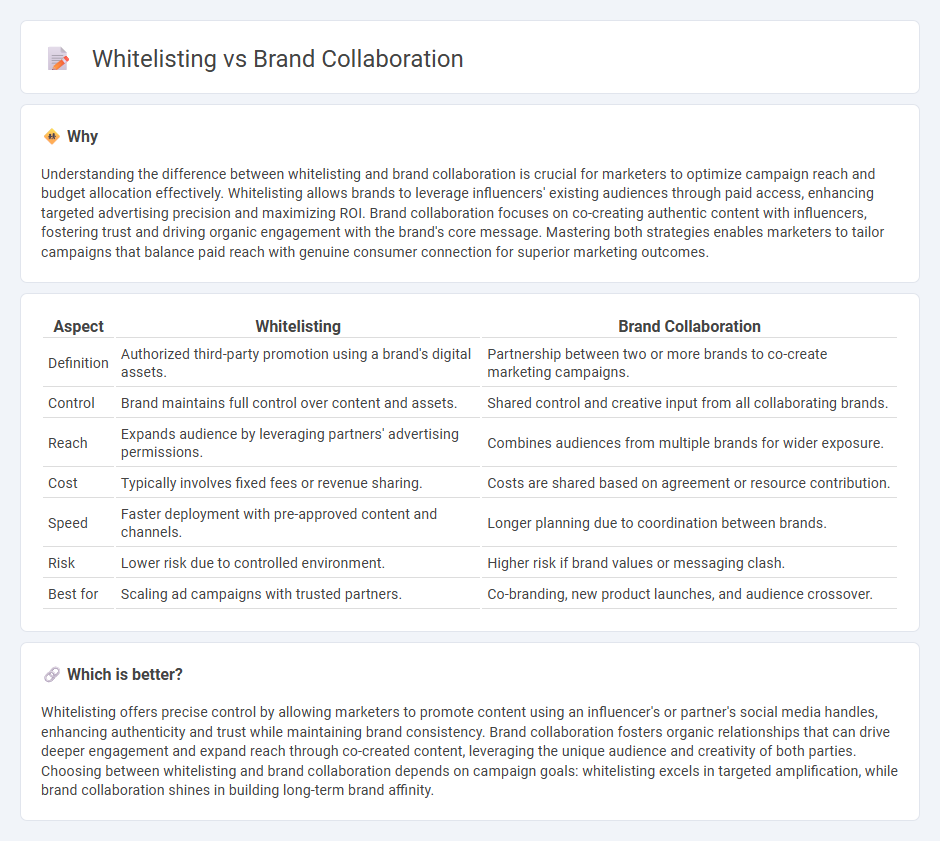
Whitelisting in marketing involves granting trusted partners permission to run ads on a brand's behalf, leveraging their audience for targeted campaigns while maintaining control over messaging and data. Brand collaboration entails two or more brands working together to create joint campaigns, combining resources and audiences to enhance reach and credibility. Discover how whitelisting and brand collaboration can elevate your marketing strategy by exploring their unique benefits and implementations.
Why it is important
Understanding the difference between whitelisting and brand collaboration is crucial for marketers to optimize campaign reach and budget allocation effectively. Whitelisting allows brands to leverage influencers' existing audiences through paid access, enhancing targeted advertising precision and maximizing ROI. Brand collaboration focuses on co-creating authentic content with influencers, fostering trust and driving organic engagement with the brand's core message. Mastering both strategies enables marketers to tailor campaigns that balance paid reach with genuine consumer connection for superior marketing outcomes.
Comparison Table
| Aspect | Whitelisting | Brand Collaboration |
|---|---|---|
| Definition | Authorized third-party promotion using a brand's digital assets. | Partnership between two or more brands to co-create marketing campaigns. |
| Control | Brand maintains full control over content and assets. | Shared control and creative input from all collaborating brands. |
| Reach | Expands audience by leveraging partners' advertising permissions. | Combines audiences from multiple brands for wider exposure. |
| Cost | Typically involves fixed fees or revenue sharing. | Costs are shared based on agreement or resource contribution. |
| Speed | Faster deployment with pre-approved content and channels. | Longer planning due to coordination between brands. |
| Risk | Lower risk due to controlled environment. | Higher risk if brand values or messaging clash. |
| Best for | Scaling ad campaigns with trusted partners. | Co-branding, new product launches, and audience crossover. |
Which is better?
Whitelisting offers precise control by allowing marketers to promote content using an influencer's or partner's social media handles, enhancing authenticity and trust while maintaining brand consistency. Brand collaboration fosters organic relationships that can drive deeper engagement and expand reach through co-created content, leveraging the unique audience and creativity of both parties. Choosing between whitelisting and brand collaboration depends on campaign goals: whitelisting excels in targeted amplification, while brand collaboration shines in building long-term brand affinity.
Connection
Whitelisting in marketing involves granting trusted partners access to promote a brand's content, enhancing authenticity and reach through brand collaboration. Collaborations enable shared audiences and resources, amplifying campaign effectiveness while maintaining brand integrity through controlled content distribution. This strategic synergy drives higher engagement and builds consumer trust by leveraging trusted influencer networks.
Key Terms
Co-branding
Brand collaboration and whitelisting both enhance market reach through strategic partnerships, but brand collaboration emphasizes co-branding where two brands jointly create and promote products or campaigns, leveraging shared identities for stronger consumer impact. Co-branding merges brand equity to produce unique product offerings or marketing messages that appeal to combined target audiences, driving mutual growth and recognition. Explore the nuances of co-branding in brand collaborations to unlock synergistic opportunities and maximize brand value.
Influencer partnerships
Brand collaboration in influencer partnerships involves co-creating content or campaigns where both the brand and influencer actively contribute to messaging and creative direction, enhancing authenticity and audience engagement. Whitelisting allows brands to use influencer content as paid ads, leveraging the influencer's established trust and reach while maintaining control over targeting and budget. Explore how each strategy can amplify your marketing impact and maximize ROI by learning more about their distinct advantages.
Ad account access
Brand collaboration allows multiple entities to share creative assets and campaign management within a single ad account, providing direct control and unified performance tracking. Whitelisting enables one brand to grant access to another's ad account for running ads, enhancing reach while maintaining strict control over audience targeting and budget settings. Explore the distinct advantages of each strategy to optimize your advertising efforts effectively.
Source and External Links
30 Brand Collaboration Examples that Went Viral - The CMO - Adidas and Kanye West's Yeezy sneaker line combined creative vision with sportswear excellence, generating massive sales and cultural impact for both brands.
The Best Brand Collaborations of 2025 - Avenue Z - Bad Bunny's partnership with Calvin Klein redefined modern masculinity and brand visibility by merging the artist's bold persona with Calvin Klein's iconic minimalist style.
15 Retail Brand Collaboration Examples (2025) - Shopify - Allbirds and Adidas co-created the Futurecraft Footprint, a highly sustainable sneaker that set a new benchmark for eco-friendly footwear innovation.
 dowidth.com
dowidth.com